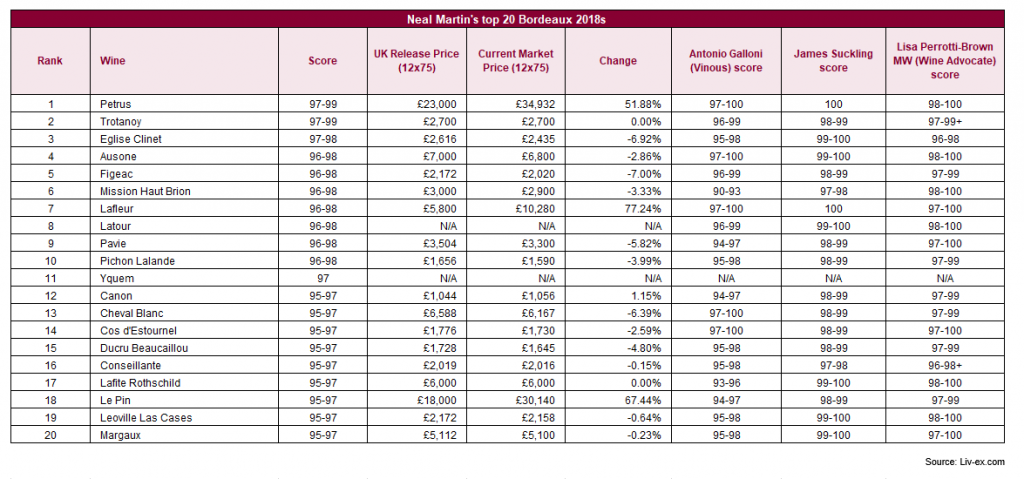“The future, like everything else, is no longer quite what it used to be”.
Yesterday evening (UK time), Neal Martin’s long-awaited Bordeaux 2018 report was published on Vinous.com. The report, titled “The Future’s Not What It Was: Bordeaux 2018”, is a unique analysis of the vintage because unlike his peers, Martin tasted the vintage away from the theatre of the UGC launch, allowing perhaps for more quiet reflection and importantly, tasting wines that were no longer babies. “Assessing wines further down their barrel maturation meant that in some cases I tasted the final blend.”
Bordeaux 2018 – “very good to excellent in quality”
Overall, Martin notes that “the 2018 vintage is very good to excellent in quality. However, it does not demonstrate the consistency of 2005 or 2016, and it lacks the pinnacles that mark 2010 and, again, 2016.”
He goes on to say that, “it is clear that 2018 is a flattering vintage and, coupled with the well-oiled promotional machine cranked up each primeur, I see how it prompted occasionally eulogistic reviews.”
As for 100-point scores? Martin comments that “there was not a single occasion when I encountered a barrel sample that intimated potential perfection. Not once. That is not being mean; it is just a sober evaluation.”
The market – “where do you begin?”
In the report, Martin devotes a section to the market. He says that you can no longer “speak of a ‘successful’ or ‘unsuccessful’ campaign that corresponds to quality because merchants no longer get behind a good vintage across the board. Those days are gone.” Instead, he says that “most pick and choose wines that are well received and sensibly priced so that they can make a decent margin.”
Martin adds that although this has been the trend for a few years, “what is changing is that this cherry-picking buying strategy is filtering back up the chain to Bordeaux négociants and knocking at château doors.” He says that historically the négociants have acted as a “buffer” between the merchants and the chateaux, whereas now “reality is beginning to bite and allocations are beginning to be politely refused.”
As for outside of Bordeaux, Martin notes that “there is a perfect storm brewing on the horizon”. He discusses the decline in interest from China, the Brexit stalemate, US tariffs and civil unrest in Hong Kong and adds that this “tumultuous world” doesn’t bode well for buying futures.
In terms of strategy, Martin argues that “something has got to give, because châteaux withholding stock is a short-term remedy to control supply and demand.” He adds that, “the problem with that strategy is that consumers are aware that this stock will appear at some point, weakening incentive to buy en primeur.” He instead says that “when wines are priced correctly, according to market conditions and not the aspirations of a château seeking to ‘reposition their brand’, then primeur and the distribution system works remarkably well. It all depends on the price. Simple.”
You can read our concluding report on the Bordeaux 2018 campaign, including its impact on the secondary market here.
Conclusion
Overall, Martin says that “there is a clutch of great wines in 2018, for certain, though I am not inclined to garland it with a ‘greatest ever’ tag.” – “It is easy to get carried away by the new vintage, at least until the next one arrives.”
Martin goes on to say that, “there is already excitement surrounding the 2019 vintage, and you can bet your bottom dollar that in a few months’ time, the sales pitch will be summed up by ‘2018-plus,’ a phrase I heard on two or three occasions.”
As for the wines, Martin adds that he only began to experience “tingles down the spine” when he broached the Right Bank, adding that “this put the Left Bank into context” and “explains why [his] adulation and highest scores learn towards the Right Bank”. Martin adds that “this is quite unexpected” due to the hot growing season but concludes that “Bordeaux is full of surprises” and “the future is never predictable and it certainly isn’t what it used to be”.
Martin’s top 20 wines can be found in the table below. You can read the full report on Vinous.com here.




